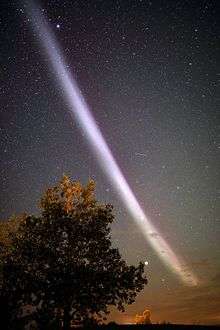Steve (atmospheric phenomenon)

Steve is an atmospheric optical phenomenon which appears as a purple and green light ribbon in the sky, formally discovered in 2017 by aurora watchers from Alberta, Canada. According to Eric Donovan's analysis of satellite data from the European Space Agency's Swarm mission, Steve is caused by a 25 km (16 mi) wide ribbon of hot gases at an altitude of 450 km (280 mi), with a temperature of 3,000 °C (3,270 K; 5,430 °F) and flowing at a speed of 6 km/s (3.7 mi/s) (compared to 10 m/s (33 ft/s) outside the ribbon). The phenomenon is not rare, but nobody had looked into it in detail prior to that.[1][2][3] In August 2018, researchers determined that the phenomenon's skyglow was not associated with particle precipitation (electrons or ions) and, as a result, could be generated in the ionosphere.[4]
Discovery and naming
The aurora watchers who first discovered Steve, members of a Facebook group called Alberta Aurora Chasers, initially attributed the phenomenon to a proton aurora and erroneously called them "proton arcs",[5] but when physics professor Eric Donovan from the University of Calgary saw the pictures, he suspected that was not the case, because proton auroras are not visible.[6] As he correlated the time and location of the phenomenon with Swarm satellite data, and Song Despins photo (not seen here) including GPS coordinates, the phenomenon was very clearly distinguished.[1]
One of the aurora watchers, photographer Chris Ratzlaff,[7] suggested the name "Steve" from Over the Hedge, an animated comedy movie from 2006, in which its characters chose that name for something unknown.[8] Reportage of the heretofore undescribed unusual "aurora" went viral as an example of citizen science on Aurorasaurus.[9][10]
A member of Alberta Aurora Chasers suggested "Strong Thermal Emission Velocity Enhancement" as a backronym of STEVE in April 2017,[11] one which has since been adopted by the team at NASA Goddard Space Flight Center studying Steve.[12]
Occurrence and cause
Steve can be spotted closer to the equator than the aurora,[13] and as of March 2018 has been observed in the United Kingdom, Canada, Alaska, northern U.S. states and New Zealand. Steve appears as a very narrow arc extending for hundreds or thousands of miles, aligned east-west. Steve generally lasts for 20 minutes to an hour. As of March 2018, Steve has only been spotted in the presence of an aurora. Steve was not observed from October 2016 to February 2017, or from October 2017 to February 2018, leading NASA to believe that Steve may only appear in certain seasons.[14]
A study published in March 2018 by Donovan, Ratzlaff, and other co-authors in the peer-reviewed journal Science Advances suggested that Steve accompanies a subauroral ion drift (SAID),[15] a fast-moving stream of extremely hot particles. Steve marks the first observed visual effect accompanying a SAID.[14] In August 2018, researchers determined that the phenomenon's skyglow was not associated with particle precipitation (electrons or ions) and, as a result, could be generated in the ionosphere.[4]
See also
| Wikimedia Commons has media related to STEVEs (Northern Lights). |
| Look up STEVE in Wiktionary, the free dictionary. |
References
- 1 2 McRae, Mike (24 April 2017). "Introducing Steve - a Newly Discovered Astronomical Phenomenon". ScienceAlert.
- ↑ "When Swarm Met Steve". ESA. 21 April 2017.
- ↑ American Geophysical Union (20 August 2018). "New kind of aurora is not an aurora at all". Physorg.com. Retrieved 2018-08-21.
- 1 2 Gallardo-Lacourt, B.; Liang, J.; Nishimura, Y.; Donovan, E. (20 August 2018). "On the Origin of STEVE: Particle Precipitation or Ionospheric Skyglow?". Geophysical Research Letters. doi:10.1029/2018GL078509.
- ↑ "Meet Steve". European Space Agency. Retrieved 2017-04-24.
- ↑ "Aurora photographers find new night sky lights and call them Steve". BBC News. 23 April 2017.
- ↑ "Amateur Sky-Watchers Discover Celestial Phenomenon, Name It 'Steve'". 24 April 2017.
- ↑ "New atmospheric phenomenon named Steve discovered by aurora watchers". ABC News. 24 April 2017.
- ↑ Rozell, Ned (2015-04-02). "Citizen science meets the aurora". University of Alaska Fairbanks Geophysical Institute.
- ↑ "7 Things to Know About "STEVE"". Aurorasaurus. 2017-03-14.
- ↑ "Introducing Steve – a newly discovered astronomical phenomenon". Googply News. 2017-04-24. Retrieved 2017-04-25.
- ↑ "Meet 'Steve,' a Totally New Kind of Aurora". 2018-03-14. Retrieved 2018-03-22.
- ↑ Saner, Emine (2018-03-19). "'Steve': the mystery purple aurora that rivals the northern lights". the Guardian. Retrieved 2018-03-22.
- 1 2 Garner, Rob (2018-03-14). "NASA Needs Your Help to Find Steve and Here's How". NASA. Retrieved 2018-03-22.
- ↑ MacDonald, Elizabeth A.; Donovan, Eric; Nishimura, Yukitoshi; Case, Nathan A.; Gillies, D. Megan; Gallardo-Lacourt, Bea; Archer, William E.; Spanswick, Emma L.; Bourassa, Notanee (2018-03-01). "New science in plain sight: Citizen scientists lead to the discovery of optical structure in the upper atmosphere". Science Advances. 4 (3): eaaq0030. doi:10.1126/sciadv.aaq0030. ISSN 2375-2548. PMC 5851661. PMID 29546244.
External links
- Eric Donovan's presentation at 2017 ESA Earth Explorer Missions Science Meeting (1:08:30 - 1:26:00)
- Alberta Aurora Chasers
- NASA Goddard with Liz MacDonald (14 March 2018). "The Aurora Named Steve". YouTube.